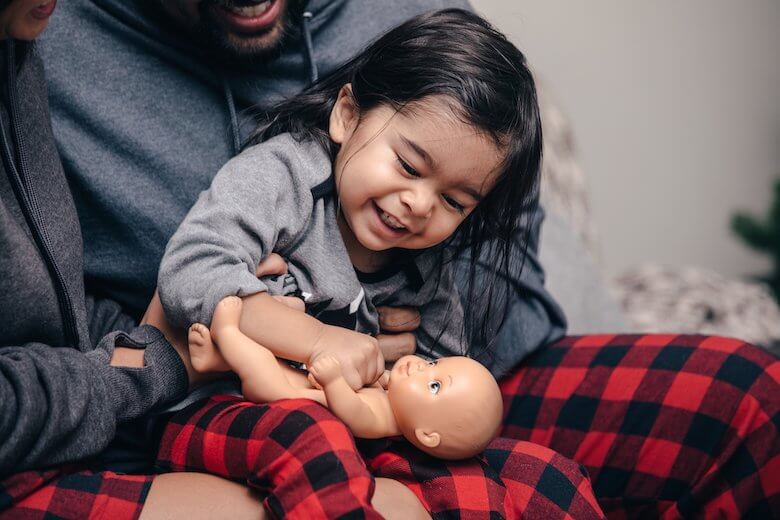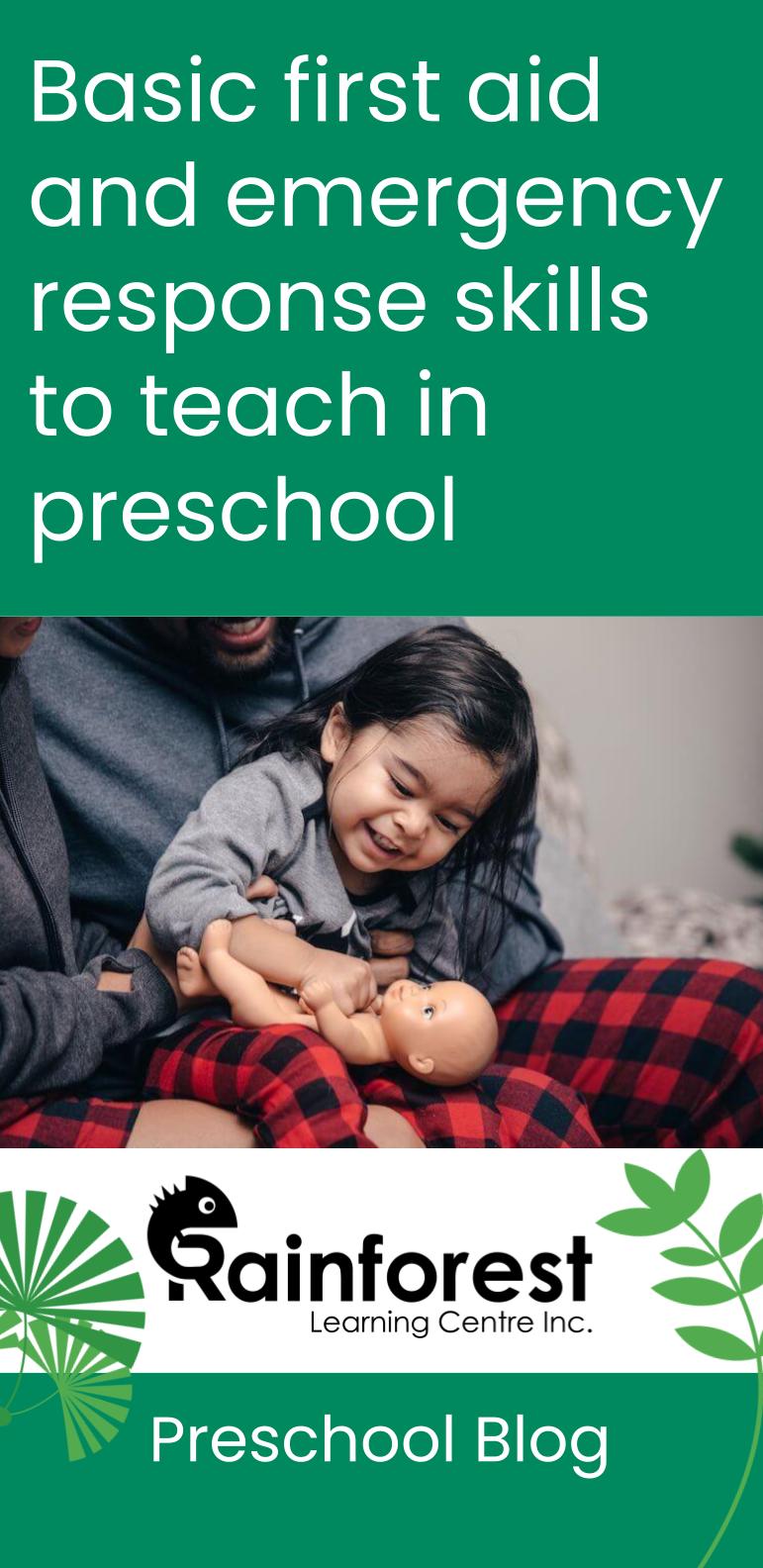
Sometimes, accidents and emergencies happen, and an adult may not be immediately available. In these cases, it’s great for kids to know some basic first aid. They can start learning young – even in the preschool years. While they may not be qualified to be pseudo paramedics, or get their first-aid certificates, they can still do a lot of good with some elementary knowledge in this field.
In this article we’ll explain some of the most simple first aid and emergency response skills to teach in the preschool years – whether at home, or in a preschool classroom.
Teach preschoolers how to clean and bandage minor cuts, scrapes, burns and other injuries
When children learn about washing their hands, and generally become more independent with their self-care, you can also teach them about washing a cut or scrape, to keep it disinfected.
Cuts and scrapes are a normal part of childhood. Learning to ride a bike, for example, is bound to come with a few ‘tips.’ Most of these are ok, and kids can get used to them fast.
But, it’s generally not a good idea for kids to ignore their cuts and scrapes. They may be enticed to keep playing in the dirt with open skin. We wouldn’t want that leading to infection. So, it’s best to teach kids at a young age that as soon as they start to see blood, they should come inside and wash with soap and warm water. Of course, they should tell an adult. But sometimes, these cuts are so minor, they may not even mention them. If a preschooler knows to keep their cuts clean, that can go a long way with prevention.
Then, teach them how to open up and stick on a bandage. This can involve some fine motor skills, so it’s a good thing to practice.
You may also want to show them where the disinfecting ointments are, or where a first-aid kit is in your house too.
If they are burned from an accident (and not sunburned), teach them to use cold water, or a cold compress, though, most likely they will ask for help with this, with you needing to remind them!
For things like bee stings and splinters, a child should know that they need to get the object out of their body, somehow. This may be a bit hard for preschoolers to figure out (but if you teach them how, and they can, then great!). So keeping them aware that they need to tell an adult about these things is important.
Teach children how to call for help on telephones in case of an emergency
Probably the most important skill to learn as a young child, is how to call for help in an emergency. If an adult around them is unconscious, or in danger, and can not be the one to call 9-1-1, or another adult for help, then knowing what to do can be life-saving. Children at this stage are probably too young to be taught CPR (if they can even bear enough weight and pressure to do it!). So before they attempt to be heroes, they need to learn how to call for help.
In our modern day and age, with cell-phone use rampant, you may not have a home phone with speed-dial to 9-1-1 anymore. Your cell phone may have a password lock to it, too. If so, there should be an emergency calling option on it, which you can teach your children to use.
You can write down the phone number of “9-1-1”, or other helpful numbers, on your fridge or somewhere noticeable, and tell your child where they can find this information in an emergency. For example, if mom, or dad or grandma or the baby-sitter is ‘sleeping’ and ‘won’t wake up’ after falling down the stairs, they should know where to look, and what to dial on the phone, and then what to say.
On this article, we saw a video embed of a young boy who did just that! He even knew how to sing his address, with a song his mother taught him.
If your child doesn’t know their address, you can also write it down, next to that list of important phone numbers, so they can at least say the numbers and letters (if they can’t read yet).
Be sure you teach your preschooler that calling 9-1-1 is only for emergencies, and they should never take it lightly.
Another option is to stay connected with neighbours you trust. If you live in an apartment building, perhaps you can teach your child to unlock and open the front door, and then knock on the neighbour’s door, to ask for help.
Or, maybe they know how to FaceTime an aunt, or a working parent who is not near them, to notify them that something is wrong.
Decide as a family what the best options are for teaching your young ones how to call for help.
Teach kids how to notice, avoid and report signs of danger or distress
Children play with other children all the time, when adults aren’t looking. It’s common in sibling households, but even just among friends, at birthday parties, at religious gatherings, on the playground, in swimming pools and so on.
By teaching the slightly older kids what to watch out for, they can be your little eyes and ears when you’re not there.
Major things to teach your kids to look out for include:
- Choking or not breathing, including anaphylaxis shock.
- Someone struggling in a swimming pool (remember, drowning is not always ‘loud’ or noticeable).
- Someone mysteriously laying on the ground, not moving (especially if they fell, or if they see blood).
- A large object on top of a child (such as furniture).
- Someone being bullied by other kids, or even by adults.
- Abuse in the home, or in another person’s home.
- Open wires or cables, fire, smoke, broken stairs or ladders, and so on (this may not be common, but it can be part of earthquake or fire safety preparedness lessons).
- Needles or condoms in an open field, or on a playground.
- Dangerous animals, such as snakes, poisonous insects, bears, and others.
- Poisonous or harmful plants (such as poison ivy).
- An out-of-place stranger asking a child to enter their vehicle or home.
Children should be fully aware of the dangers that can cause harm to others. They should know what to report, and how urgent it is to tell another adult, or call for help, as explained above. Make sure they understand this is not ‘tattling’ on others, and it’s safe to do so.
In addition to the really dangerous stuff, children should also be aware of basic safety ‘rules’ of life, such as not eating spoiled food (or telling an adult if another child did), wearing a helmet when riding a bike, putting on sunscreen to avoid burns, staying away from weapons and chemicals in the home, street rules and what common allergens or choking hazards are, and so on.
For example, four and five year olds should know that their baby sibling should not ever be given legos or marbles to ‘play’ with, and that they shouldn’t try to feed them. If they see a baby sibling struggling for air, or turning red, they should call for help right away.
Play ‘doctor’ to learn about common medical, life-saving skills in a light-hearted way
Did you know that real medical professionals have to ‘play doctor’ all the time, to learn what to do in emergency situations? Role playing is essential to being prepared. You can do this in a light-hearted way with your children, and make it fun with a game. Teach them basics like how to check if someone is breathing, or even how to do simple CPR and survival tasks.
You can teach them how to do back blows to help someone who is choking (use a teddy or doll for this). They can learn to ‘stop, drop and roll’ with you, so they know what to do if they are on fire. They can learn how to roll you over gently, to put you in a recovery position. Or, perhaps they can learn how to use a basic first-aid kit that you put together with them. Show them the gauze, the rubbing alcohol, and how to use it all safely.
There are, of course, ‘doctor’ toys you can buy to aid in the fun. But while doing this, do find a way to explain to children that in a real situation, all of this role-playing still applies. And, be sure they know that they should still call for help!
Of course, reading books on this topic may help with role playing. You can read the story of what happened to a character, and then act it out.
Take ‘real’ first-aid lessons, designed for children
There are organizations that specialize in teaching first-aid in schools. There are also some curriculum materials, like colouring books, designed to teach basic first aid to young children. You can invite one of these teachers to your classroom, or enrol your children in a course to learn about these things with them.
To conclude: don’t scare children with first aid lessons, teach them
As a final word, we will say this: it would not be helpful to scare children with all this talk of emergencies and ‘bad’ things happening. It can be hard to imagine that a loved one is hurting, or that danger is imminent. So, be sure to keep things positive and productive. For example, above we linked to a video of a child who learned to sing his address, and how to call 9-1-1. So, learning to sing an address can be a fun way to start these types of lessons. Teaching a child to care for their teddy bear who needs a band-aid, or a back blow, is also a ‘light’ way of teaching them this type of skill. Start with the skill, not the fear.
Then, when things do happen, they will hopefully remember what they learned, and will know to respond as rationally, and as quickly as possible, without going into ‘freeze and cry’ mode. And, without being totally ignorant about it.
